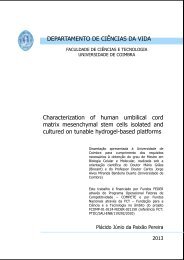Regulation of Apoptosis and Differentiation by p53 in Human ...
Regulation of Apoptosis and Differentiation by p53 in Human ...
Regulation of Apoptosis and Differentiation by p53 in Human ...
Create successful ePaper yourself
Turn your PDF publications into a flip-book with our unique Google optimized e-Paper software.
CHAPTER 1: Introduction<br />
St<strong>and</strong>ard method<br />
Serum-free method on<br />
feeder layer<br />
Serum-free method on<br />
Matrigel<br />
•6x10 4 cells/cm 2 Feeders<br />
•Serum conta<strong>in</strong><strong>in</strong>g medium<br />
•Mechanical passag<strong>in</strong>g<br />
•2x10 4 cells/cm 2 Feeders<br />
•Serum replacement medium plus<br />
FGF-2<br />
•Non-mechanical passag<strong>in</strong>g<br />
(enzymatic or non-enzymatic)<br />
•Matrices <strong>and</strong> no Feeders<br />
•MEF conditioned medium plus FGF-2<br />
•Passag<strong>in</strong>g (enzymatic or non-enzymatic)<br />
Overview <strong>of</strong><br />
plate (day 7)<br />
Colony detail<br />
(at passag<strong>in</strong>g)<br />
Overview<br />
<strong>of</strong> plate (day 1<br />
after passag<strong>in</strong>g)<br />
FIGURE 1.2- Different methods <strong>of</strong> cultur<strong>in</strong>g <strong>of</strong> hESC (adapted from Gr<strong>and</strong>ela <strong>and</strong> Wolvetang, 2007).<br />
1.1.4- Ma<strong>in</strong>tenance factors <strong>of</strong> self-renewal <strong>and</strong> pluripotency<br />
In order to have a cont<strong>in</strong>uous source <strong>of</strong> hESC for research <strong>and</strong> therapeutic purposes, it is<br />
essential to ma<strong>in</strong>ta<strong>in</strong> them for extended periods <strong>in</strong> their undifferentiated state. ESC self-renewal<br />
can be ma<strong>in</strong>ta<strong>in</strong>ed <strong>in</strong> vitro <strong>by</strong> cultur<strong>in</strong>g cells <strong>in</strong> the presence <strong>of</strong> specific factors.<br />
1.1.4.1- LIF<br />
LIF, a cytok<strong>in</strong>e that belongs to the IL-6 family, is sufficient to ma<strong>in</strong>ta<strong>in</strong> mESC without the<br />
presence <strong>of</strong> feeders or serum conta<strong>in</strong><strong>in</strong>g medium. LIF acts via heterodimerization <strong>of</strong> two<br />
members <strong>of</strong> class I cytok<strong>in</strong>es, the low aff<strong>in</strong>ity LIF receptor (LIFR) <strong>and</strong> the signal transducer gp130<br />
(Davis et al., 1993; Gear<strong>in</strong>g et al., 1992) <strong>and</strong> ultimately activates the Jak/STAT pathway that is<br />
sufficient for self-renewal <strong>in</strong> these cells (Boeuf et al., 1997; Matsuda et al., 1999; Nakamura et al.,<br />
1998; Niwa et al., 1998). Although the LIFR <strong>and</strong> gp130 are present <strong>in</strong> hESC, <strong>and</strong> there is<br />
activation <strong>of</strong> STAT members <strong>in</strong> response to recomb<strong>in</strong>ant human LIF or mouse LIF (Daheron et al.,<br />
2004; Humphrey et al., 2004), this is not sufficient to ma<strong>in</strong>ta<strong>in</strong> hESC <strong>in</strong> an undifferentiated state.<br />
- 9 -
















